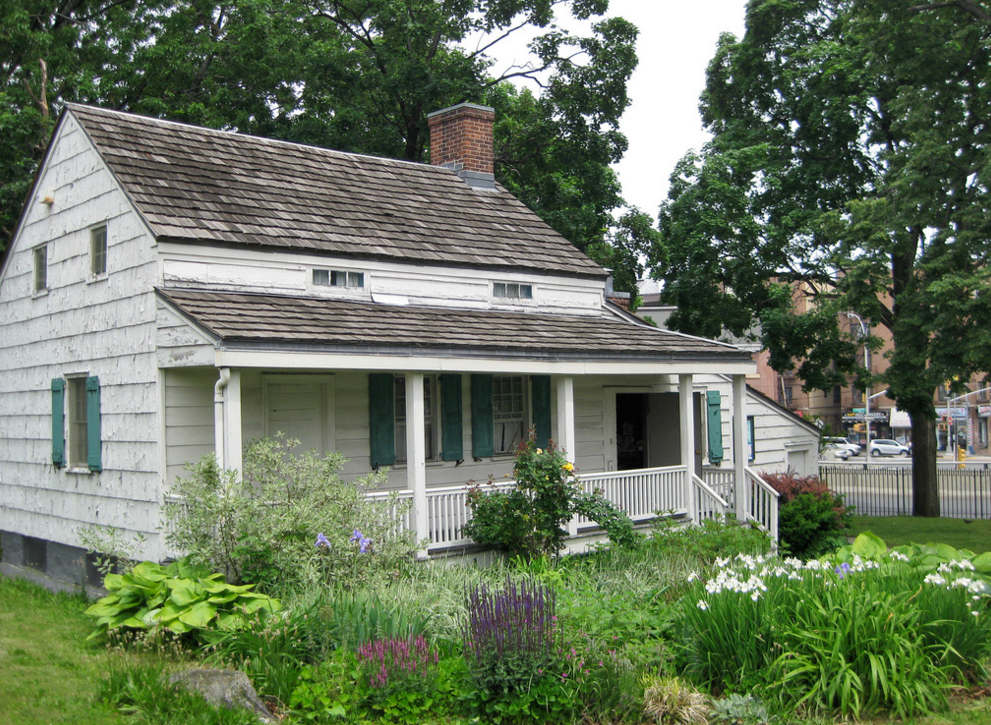Given Edgar Allan Poe’s legacy as the father of the modern horror story, New Yorkers with a literary bent this Halloween season ought to treat themselves to one of the city’s smallest treasures: Poe Cottage.

Poe Cottage. (Source: Courtney “Coco” Mault, via Flickr Creative Commons)
Located in Poe Park on the Grand Concourse in the Bronx, the little white house was the author’s home from 1846 until his death during that fateful trip to Baltimore in the fall of 1849. After several years of writing and trying to survive in New York City since his move there in 1844, Poe spied the modest laborer’s cottage near where Fordham University now sits, and immediately fell for the place. Poe memorialized this real estate epiphany in his final published story, according to Smithsonian Magazine.
“This modest building also served as the inspiration for the final Poe story published during the author’s life, ‘Landor’s Cottage,’ which appeared in the June 9, 1849, issue of Flag of Our Union, four months before his death. A far cry from the tales of woe and horror Poe is widely known for, the story of ‘Landor’s Cottage’ is quite simple: a man hiking through the bucolic setting of rural New York comes across a small house and marvels at its picturesque perfection, finding that it “struck me with the keenest sense of combined novelty and propriety — in a word, of poetry”.
Contrary to the thriller material he summoned from his stellar imagination and his penchant for tapping into the psychology of human darkness, the cottage was not spooky or weird or haunted. It was just neat, tidy, sparsely furnished but, yet, a home. Poe found the cottage so inspiring, he rented it for $100 a year and moved from West 84th Street in Manhattan to this then rural Fordham section of the Bronx. The 1812 cottage then sat on about two acres of land. He lived there with his young wife, Virginia, for whom he sought more country setting to combat her tuberculosis.
That plan did not work, however, as Virginia died of the disease in 1847 in the downstairs bedroom of the cottage. Poe’s mother-in-law continued to live in the cottage until after his mysterious death in 1849, after which the cottage turned to neglect and its condition worsened amidst rapid urban growth in the Bronx.
“The cottage changed hands a few times and gradually fell in disrepair as the pastoral countryside became more and more urban. The area’s upper class residents came to see it as an eyesore and an obstruction to progress, and by the 1890s Poe’s house seemed destined for demolition. The growing controversy surrounding the cottage’s future was well-reported by The New York Times, which published a passionate article arguing in favor of preservation,’’ Smithsonian Magazine wrote.
Finally, with the widening of Kingsbridge Road in 1895, New York Shakespeare Society members lobbied the New York State Legislature to relocate Poe’s cottage. The park was authorized and opened in 1902 and the house finally moved to its new site in 1913, when it was opened to the public.
When the circular bandstand was erected in 1925, the park became a hub of the community’s social life, with regular classical music concerts drawing large crowds. From the 1940s to the 1960s, Con Edison sponsored name band concerts and dance contests at Poe Park. Artists included Jimmy Dorsey, Benny Goodman, and Glenn Miller. Cultural happenings in the 1970s included music concerts and folk dancing events.
Poe Cottage fell into disrepair in the early 1970s, and The Bronx County Historical Society became its permanent custodian in 1975. In 1980, the building was placed on the National Register of Historic Places. The main floor is sparsely furnished with, among other items, a rocking chair, bed, and mirror that may have been used by Poe. A narrow staircase winds up to the attic bedroom, which has a ceiling barely six feet high. Visitors to Poe Cottage are treated to a fascinating glimpse of The Bronx’s rural past and an intimate portrait of the life of Edgar Allan Poe, one of America’s most brilliant and tormented literary figures. — NYC Dept. of Parks & Rec
The story of Poe’s Cottage survival over the centuries is fraught, though not quite on the same scale as the psychological thrillers that Poe penned. A person could drive through the Bronx every day and never notice this little time capsule from the pastoral days of old New York. However, due to Poe’s genius as the creative forefather of the horror tale, his Bronx dwelling endures. So re-read “The Raven” and plug in the address of Poe Park on your smartphone. Tis the season for a walk into the past.
Related:
- What is NYC’s Landmarks Law?
- Enduring Image in Lenox Hill: Breakfast at Tiffany’s House
- See Former Lives of NYC Buildings









